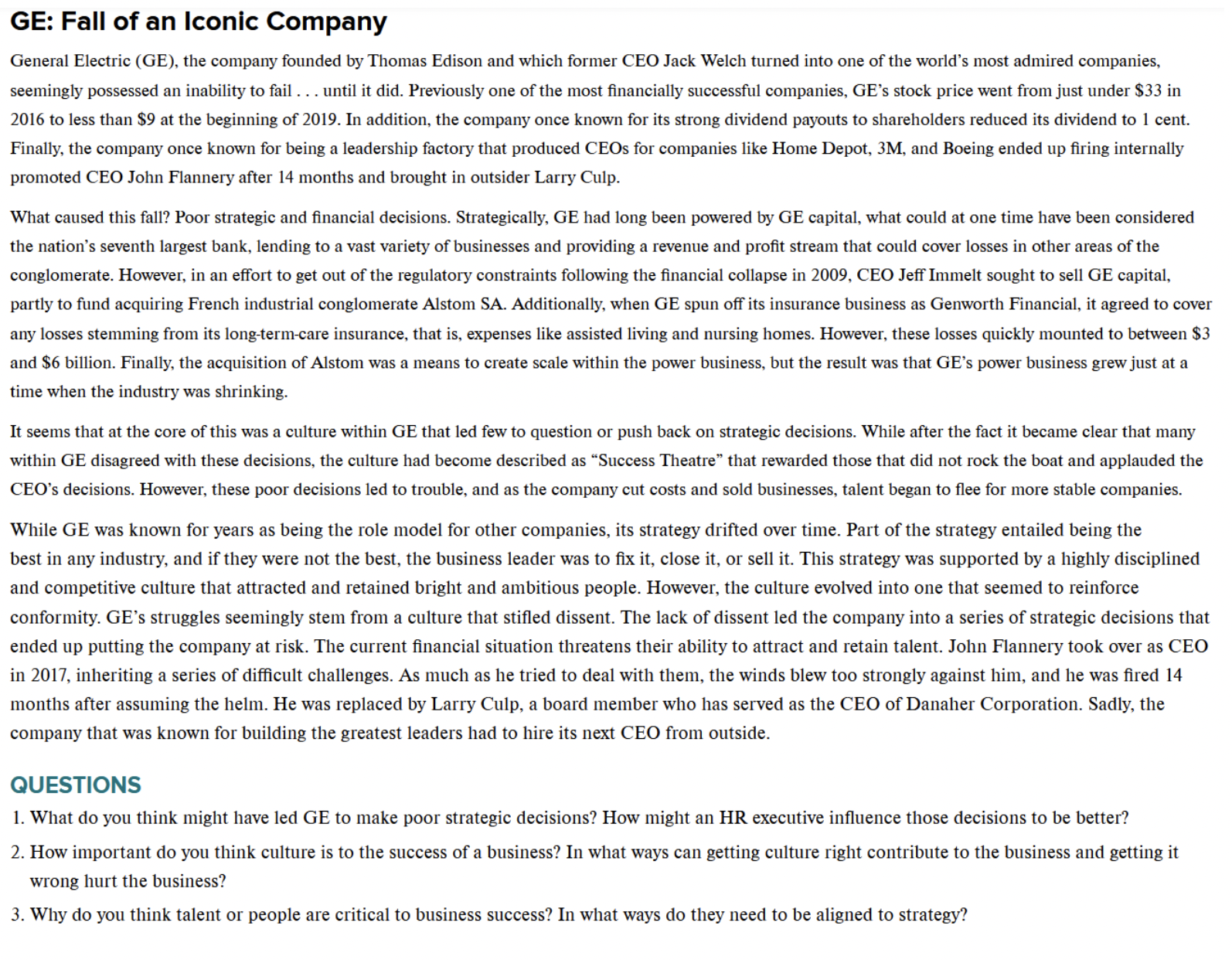Answered step by step
Verified Expert Solution
Question
1 Approved Answer
Help me answer these please :) 1-2 pages double spaced. General Electric (GE), the company founded by Thomas Edison and which former CEO Jack Welch

Help me answer these please :) 1-2 pages double spaced.
General Electric (GE), the company founded by Thomas Edison and which former CEO Jack Welch turned into one of the world's most admired companies, seemingly possessed an inability to fail . . . until it did. Previously one of the most financially successful companies, GE's stock price went from just under \$33 in 2016 to less than $9 at the beginning of 2019. In addition, the company once known for its strong dividend payouts to shareholders reduced its dividend to 1 cent. Finally, the company once known for being a leadership factory that produced CEOs for companies like Home Depot, 3M, and Boeing ended up firing internally promoted CEO John Flannery after 14 months and brought in outsider Larry Culp. What caused this fall? Poor strategic and financial decisions. Strategically, GE had long been powered by GE capital, what could at one time have been considered the nation's seventh largest bank, lending to a vast variety of businesses and providing a revenue and profit stream that could cover losses in other areas of the conglomerate. However, in an effort to get out of the regulatory constraints following the financial collapse in 2009, CEO Jeff Immelt sought to sell GE capital, partly to fund acquiring French industrial conglomerate Alstom SA. Additionally, when GE spun off its insurance business as Genworth Financial, it agreed to cove any losses stemming from its long-term-care insurance, that is, expenses like assisted living and nursing homes. However, these losses quickly mounted to between $3 and $6 billion. Finally, the acquisition of Alstom was a means to create scale within the power business, but the result was that GE's power business grew just at a time when the industry was shrinking. It seems that at the core of this was a culture within GE that led few to question or push back on strategic decisions. While after the fact it became clear that many within GE disagreed with these decisions, the culture had become described as "Success Theatre" that rewarded those that did not rock the boat and applauded the CEO's decisions. However, these poor decisions led to trouble, and as the company cut costs and sold businesses, talent began to flee for more stable companies. While GE was known for years as being the role model for other companies, its strategy drifted over time. Part of the strategy entailed being the best in any industry, and if they were not the best, the business leader was to fix it, close it, or sell it. This strategy was supported by a highly disciplined and competitive culture that attracted and retained bright and ambitious people. However, the culture evolved into one that seemed to reinforce conformity. GE's struggles seemingly stem from a culture that stifled dissent. The lack of dissent led the company into a series of strategic decisions that ended up putting the company at risk. The current financial situation threatens their ability to attract and retain talent. John Flannery took over as CEO in 2017, inheriting a series of difficult challenges. As much as he tried to deal with them, the winds blew too strongly against him, and he was fired 14 months after assuming the helm. He was replaced by Larry Culp, a board member who has served as the CEO of Danaher Corporation. Sadly, the company that was known for building the greatest leaders had to hire its next CEO from outside. QUESTIONS 1. What do you think might have led GE to make poor strategic decisions? How might an HR executive influence those decisions to be better? 2. How important do you think culture is to the success of a business? In what ways can getting culture right contribute to the business and getting it wrong hurt the business? 3. Why do you think talent or people are critical to business success? In what ways do they need to be aligned to strategy
Step by Step Solution
There are 3 Steps involved in it
Step: 1

Get Instant Access to Expert-Tailored Solutions
See step-by-step solutions with expert insights and AI powered tools for academic success
Step: 2

Step: 3

Ace Your Homework with AI
Get the answers you need in no time with our AI-driven, step-by-step assistance
Get Started


